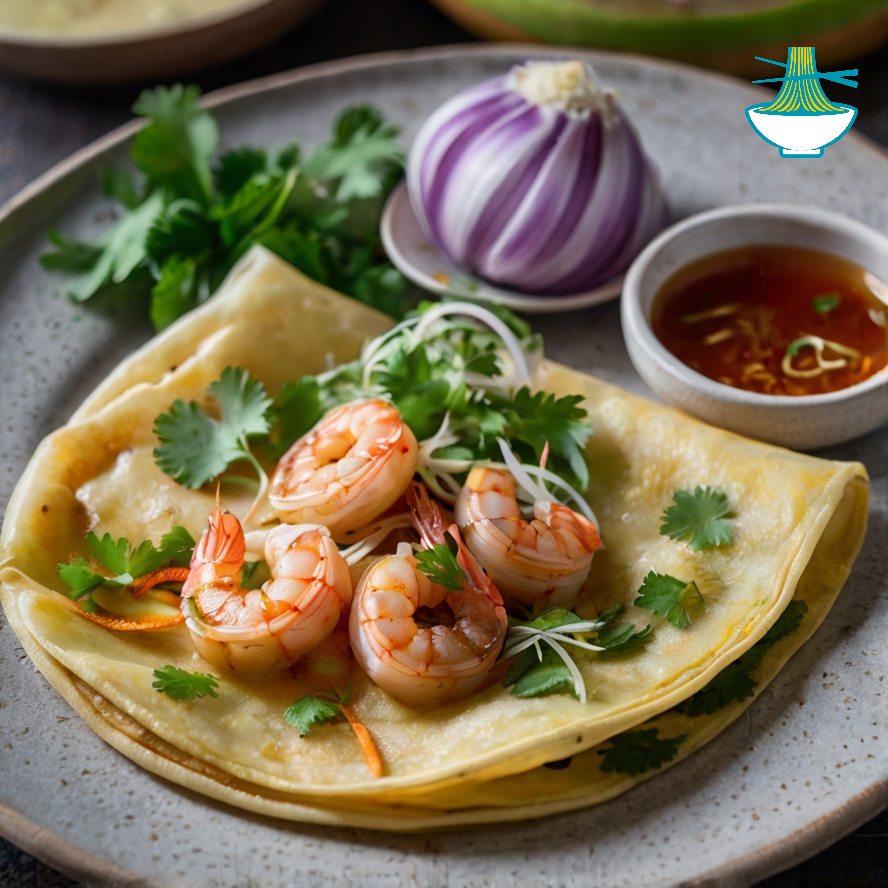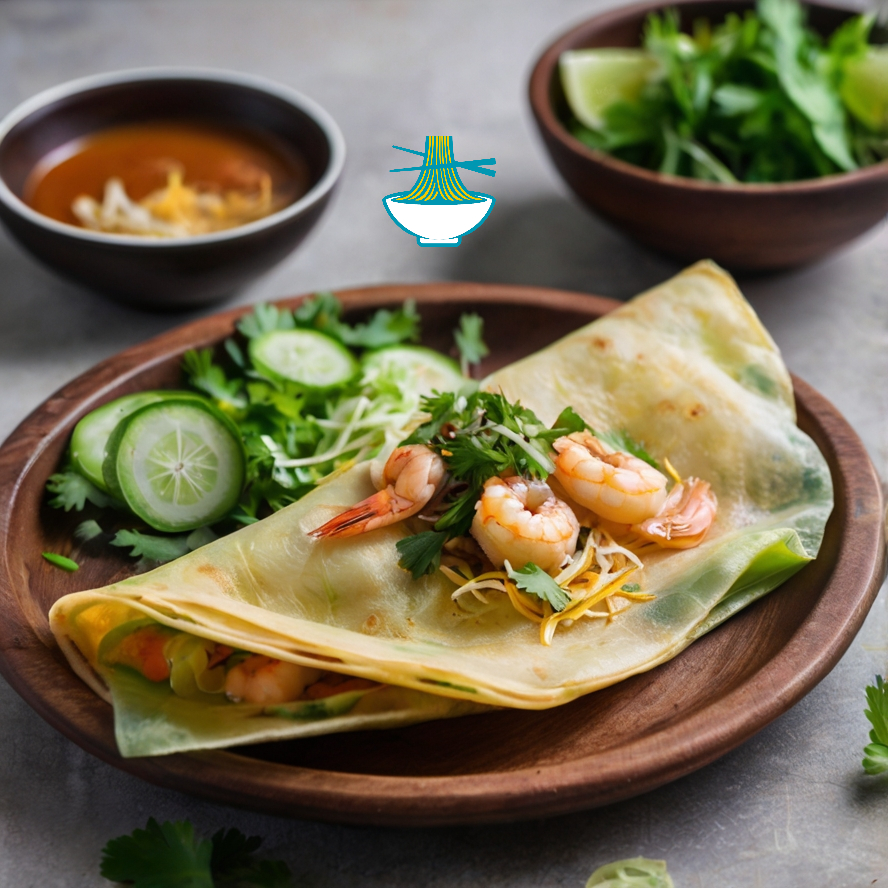Banh Xeo is a beloved Vietnamese dish known for its crispy, golden-yellow crepe filled with a savory mixture of shrimp, pork, bean sprouts, and fresh herbs. The name "Banh Xeo" translates to "sizzling cake," referring to the sound the batter makes when poured onto a hot skillet. 
This dish has a rich history dating back to ancient Vietnamese culinary traditions. It originated in the southern region of Vietnam, where it was often enjoyed as a street food delicacy. The crepe batter is typically made from rice flour, coconut milk, and turmeric, giving it a vibrant color and fragrant flavor.
Traditionally, Banh Xeo is served with lettuce leaves, which are used to wrap the crispy crepe along with fresh herbs like mint, cilantro, and basil. Dipping sauces such as nuoc cham, a tangy fish sauce-based condiment, add a burst of flavor to each bite.
Over time, Banh Xeo has become popular not only in Vietnam but also in various Vietnamese restaurants worldwide, delighting food enthusiasts with its combination of textures and harmonious blend of ingredients.
Ingredients:
- 1 cup rice flour
- 1 cup coconut milk
- 1 1/2 cups water
- 1/2 teaspoon turmeric powder
- 1/2 teaspoon salt
- 1/2 cup diced pork belly or cooked shrimp
- 1/2 cup bean sprouts
- 1/4 cup sliced green onions
- Fresh herbs (cilantro, mint, basil)
- Lettuce leaves
- Cooking oil
Dipping Sauce:
- 2 tablespoons fish sauce
- 2 tablespoons lime juice
- 1 tablespoon sugar
- 1 garlic clove, minced
- 1 small chili, minced (optional)

Instructions:
1. In a mixing bowl, combine rice flour, coconut milk, water, turmeric powder, and salt. Whisk until smooth to make the crepe batter. Let it rest for 30 minutes.
2. Heat a non-stick skillet over medium heat and add a teaspoon of oil. Add a few slices of pork belly or shrimp, bean sprouts, and green onions to one side of the skillet.
3. Pour a ladleful of the crepe batter over the ingredients, tilting the skillet to spread the batter evenly.
4. Cover the skillet and cook for 2-3 minutes until the crepe is crispy and golden.
5. Fold the crepe in half and transfer it to a plate. Repeat the process for the remaining batter and filling ingredients.
6. Serve Banh Xeo with lettuce leaves and fresh herbs for wrapping. Mix the dipping sauce ingredients in a bowl and serve alongside the crepes.
Enjoy your crispy Banh Xeo with the flavorful dipping sauce and fresh herbs!
Nutrition Value:
1. 1 cup rice flour:
- Calories: Approximately 578 calories
- Carbohydrates: Around 128 grams
- Protein: Roughly 8 grams
- Fat: Minimal, about 1 gram
- Sodium: Very low, around 3 milligrams
- Cholesterol: Zero
- Vitamins and minerals: Contains small amounts of iron, calcium, and B vitamins
- Nutritional benefit: Rice flour is gluten-free and suitable for those with gluten intolerance or celiac disease. It provides energy from carbohydrates and some essential nutrients.
2. 1 cup coconut milk:
- Calories: Approximately 445 calories
- Carbohydrates: Around 6 grams
- Protein: Roughly 5 grams
- Fat: High, about 48 grams (mostly healthy fats)
- Sodium: Very low, around 15 milligrams
- Cholesterol: Zero
- Vitamins and minerals: Contains significant amounts of manganese, copper, and selenium
- Nutritional benefit: Coconut milk provides healthy fats, which can support heart health and provide sustained energy. It also adds a rich flavor to dishes.
3. 1 1/2 cups water:
- Calories: Zero
- Carbohydrates: Zero
- Protein: Zero
- Fat: Zero
- Sodium: Zero
- Cholesterol: Zero
- Vitamins and minerals: None
- Nutritional benefit: Water is essential for hydration and helps in the cooking process without adding calories or nutrients.
4. 1/2 teaspoon turmeric powder:
- Calories: Approximately 9 calories
- Carbohydrates: Around 2 grams
- Protein: Roughly 0.2 grams
- Fat: Minimal, about 0.1 gram
- Sodium: Very low, around 1 milligram
- Cholesterol: Zero
- Vitamins and minerals: Contains significant amounts of curcumin (the active compound in turmeric), manganese, and iron
- Nutritional benefit: Turmeric is known for its anti-inflammatory and antioxidant properties. It adds flavor and color to dishes.
5. 1/2 teaspoon salt:
- Calories: Zero
- Carbohydrates: Zero
- Protein: Zero
- Fat: Zero
- Sodium: Varies based on type and quantity; typically, around 1150 milligrams per teaspoon
- Cholesterol: Zero
- Vitamins and minerals: None
- Nutritional benefit: Salt enhances flavor in food but should be consumed in moderation due to its sodium content.
6. 1/2 cup diced pork belly or cooked shrimp:
- Calories: Varies (approximately 200-300 calories for pork belly, around 100 calories for shrimp)
- Carbohydrates: Minimal (around 1-2 grams for pork belly, negligible for shrimp)
- Protein: High (around 15-20 grams for pork belly, around 20 grams for shrimp)
- Fat: High (around 15-25 grams for pork belly, minimal for shrimp)
- Sodium: Varies based on preparation
- Cholesterol: High (varies based on preparation, generally higher in pork belly)
- Vitamins and minerals: Contains significant amounts of protein, B vitamins, and minerals like iron and zinc
- Nutritional benefit: Provides protein for muscle building and repair, along with essential nutrients depending on the source (pork or shrimp).
7. 1/2 cup bean sprouts:
- Calories: Approximately 15 calories
- Carbohydrates: Around 3 grams
- Protein: Roughly 1 gram
- Fat: Minimal, about 0.1 gram
- Sodium: Very low, around 6 milligrams
- Cholesterol: Zero
- Vitamins and minerals: Contains vitamin C, vitamin K, folate, and small amounts of other nutrients
- Nutritional benefit: Bean sprouts are low in calories and rich in vitamins and minerals, especially vitamin C, which supports immune function.
8. 1/4 cup sliced green onions:
- Calories: Approximately 10 calories
- Carbohydrates: Around 2 grams
- Protein: Roughly 0.5 grams
- Fat: Minimal, about 0.1 gram
- Sodium: Very low, around 2 milligrams
- Cholesterol: Zero
- Vitamins and minerals: Contains vitamin K, vitamin C, and small amounts of other nutrients
- Nutritional benefit: Green onions add flavor and provide some vitamins and minerals, particularly vitamin K for bone health.
9. Fresh herbs (cilantro, mint, basil):
- Calories: Varies (typically negligible per serving)
- Carbohydrates: Varies (typically minimal per serving)
- Protein: Varies (typically minimal per serving)
- Fat: Varies (typically minimal per serving)
- Sodium: Varies (typically very low per serving)
- Cholesterol: Zero
- Vitamins and minerals: Rich in various vitamins and antioxidants, depending on the herb
- Nutritional benefit: Fresh herbs add flavor, aroma, and micronutrients to dishes. They can contribute antioxidants and other health-promoting compounds.
10. Lettuce leaves:
- Calories: Approximately 5 calories per cup (iceberg lettuce)
- Carbohydrates: Around 1 gram per cup
- Protein: Roughly 0.5 grams per cup
- Fat: Minimal, about 0.1 gram per cup
- Sodium: Very low, around 5 milligrams per cup
- Cholesterol: Zero
- Vitamins and minerals: Contains vitamin A, vitamin K, folate, and small amounts of other nutrients
- Nutritional benefit: Lettuce provides fiber, vitamins, and minerals with minimal calories, making it a good choice for adding crunch and freshness to dishes.
11. Cooking oil:
- Calories: Varies depending on type and quantity (typically around 120 calories per tablespoon for vegetable oil)
- Carbohydrates: Zero
- Protein: Zero
- Fat: High (typically around 14 grams per tablespoon for vegetable oil)
- Sodium: Zero
- Cholesterol: Zero
- Vitamins and minerals: Depends on the type of oil; some oils may contain vitamin E and other nutrients
- Nutritional benefit: Cooking oil provides essential fats for energy and helps in cooking food, but excessive consumption can contribute to calorie intake. Choosing healthy oils like olive oil or avocado oil can offer additional health benefits.
Dipping Sauce:
1. 2 tablespoons fish sauce:
- Calories: Approximately 20 calories
- Carbohydrates: Around 3 grams
- Protein: Roughly 2 grams
- Fat: Minimal, about 0.2 grams
- Sodium: High, around 2400 milligrams
- Cholesterol: Zero
- Vitamins and minerals: Contains small amounts of vitamins and minerals, primarily sodium
- Nutritional benefit: Fish sauce adds umami flavor to dishes and is a source of protein. However, it is high in sodium, so it should be used in moderation, especially for those watching their sodium intake.
2. 2 tablespoons lime juice:
- Calories: Approximately 8 calories
- Carbohydrates: Around 3 grams
- Protein: Roughly 0.1 gram
- Fat: Minimal, about 0.1 gram
- Sodium: Very low, around 1 milligram
- Cholesterol: Zero
- Vitamins and minerals: Rich in vitamin C, small amounts of other vitamins and minerals
- Nutritional benefit: Lime juice adds acidity and vitamin C to the dish, enhancing flavor and providing a boost of antioxidants.
3. 1 tablespoon sugar:
- Calories: Approximately 49 calories
- Carbohydrates: Around 12 grams
- Protein: Zero
- Fat: Zero
- Sodium: Zero
- Cholesterol: Zero
- Vitamins and minerals: No significant vitamins or minerals
- Nutritional benefit: Sugar adds sweetness to the dish but provides empty calories with no nutritional benefits. Using it in moderation is recommended for a balanced diet.
4. 1 garlic clove, minced:
- Calories: Approximately 4 calories
- Carbohydrates: Around 1 gram
- Protein: Roughly 0.2 grams
- Fat: Minimal, about 0.1 gram
- Sodium: Very low, around 1 milligram
- Cholesterol: Zero
- Vitamins and minerals: Contains small amounts of vitamin C, vitamin B6, and manganese
- Nutritional benefit: Garlic adds flavor to dishes and contains compounds that may offer health benefits, such as potential immune-boosting properties.
5. 1 small chili, minced (optional):
- Calories: Approximately 4 calories
- Carbohydrates: Around 1 gram
- Protein: Roughly 0.2 grams
- Fat: Minimal, about 0.1 gram
- Sodium: Very low, around 1 milligram
- Cholesterol: Zero
- Vitamins and minerals: Contains vitamin C, vitamin A, and small amounts of other nutrients
- Nutritional benefit: Chilies add heat and flavor to dishes. They also contain capsaicin, which may have metabolism-boosting and pain-relieving properties, although the amounts in a single chili are relatively small.


Comments